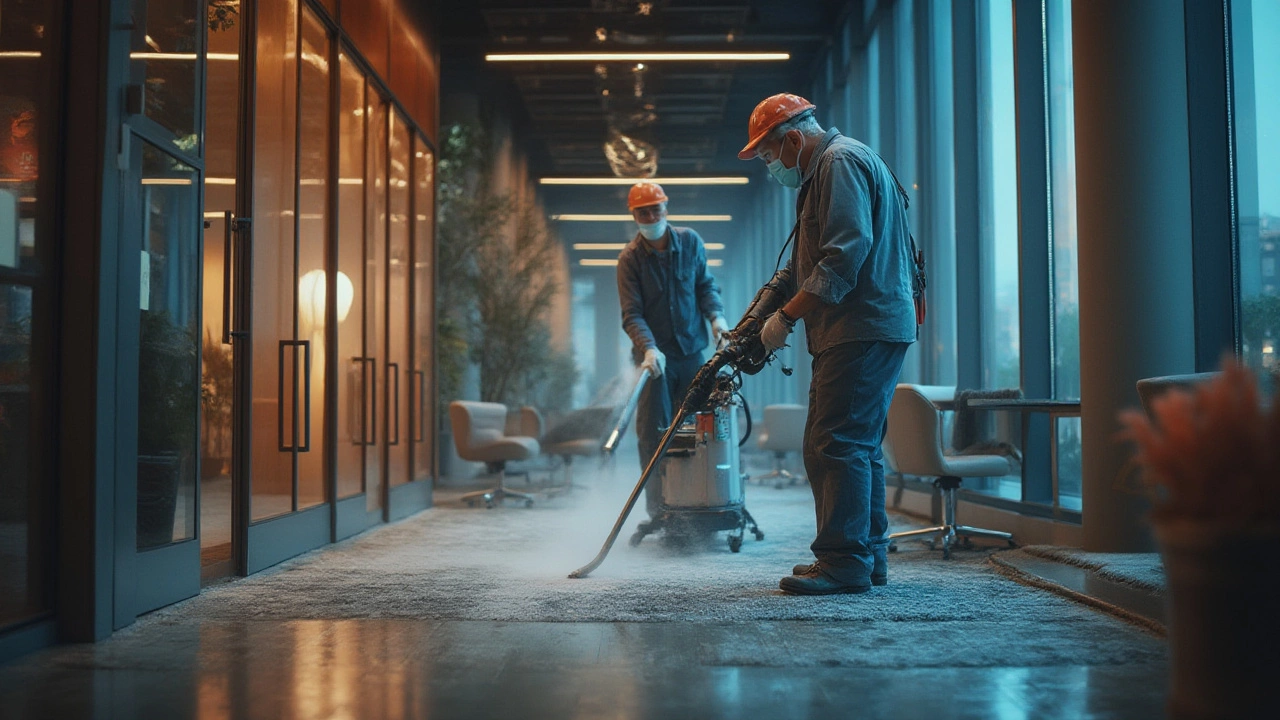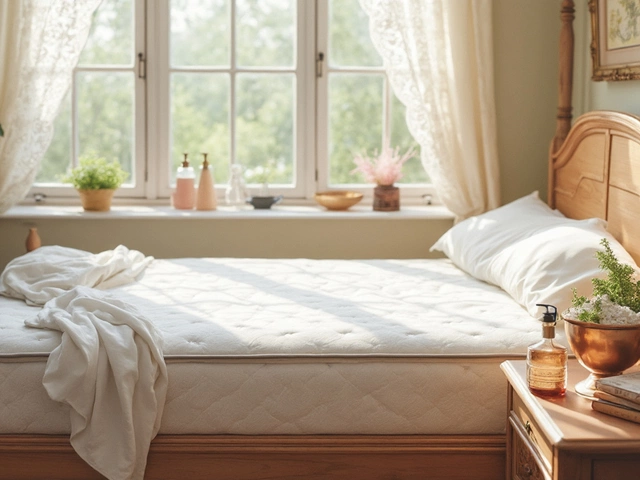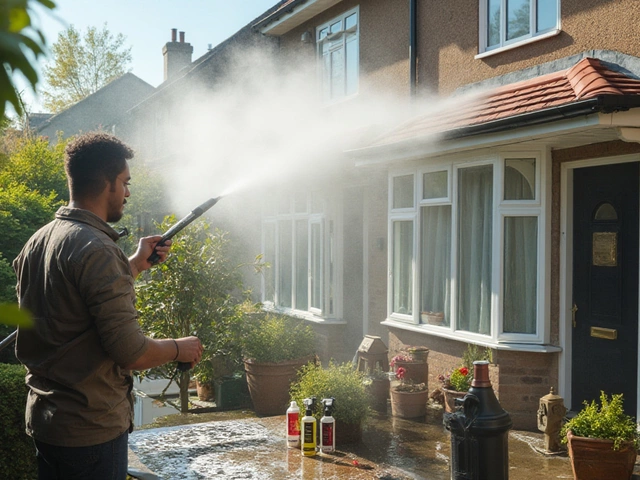Picture this: you walk into an office first thing in the morning. The sunlight bounces off spotless desks, bins are empty, and there’s just a hint of lemon in the air. Feels good, doesn’t it? It’s the work of serious office cleaning behind the scenes. Most people rarely think about all the little things that go into keeping an office not just tidy, but sanitary and efficient. But there’s a lot going on, every single day, sometimes overnight, so that business can function without a hitch. Office cleaning isn’t just about appearances—it’s about health, productivity, and a bunch of tasks that, when ignored, spell chaos (and a few raised eyebrows from the boss).
Daily Office Cleaning Essentials
The basics might seem obvious, but they matter most. Daily cleaning tasks stop mess before it becomes a problem and keep everyone feeling comfortable. There’s the visible stuff, like wiping down desks, chairs, and meeting tables. Then there’s everything else: emptying bins before they turn into an angry mountain of used coffee cups, sweeping and vacuuming floors so no one slips on muffin crumbs or drags in more dirt. Restrooms always need freshening up—think disinfecting toilet seats, sinks, faucets, and door handles—these spots collect germs faster than staff can refill their tea mugs. And don’t forget high-touch surfaces: door plates, printer buttons, shared phones, light switches—these spots become invisible petri dishes if not wiped down daily. For some offices, kitchenettes get the same treatment: microwaves, fridges, and worktops need constant attention to avoid smells and sticky surprises. The aim: create a clean, safe environment for everyone, every single day.
Most offices use a checklist to tick off core jobs, and it’s not just a box-ticking exercise. Cleaning staff need to monitor soap dispensers, hand sanitiser stations, and keep supplies topped up. Bin liners need changing before they split; floors not just swept, but checked for stains or spills. Window sills, air vents, and even the edges around skirting boards—dust builds up fast, and a quick daily check helps keep allergies and complaints to a minimum. Commercial cleaning staff are often in and out fast, so efficiency is key—good ones know exactly where dirt hides and get it sorted with barely a trace. For open-plan offices, it’s even more important: more people, more germs, more risk. A 2023 survey found the average office desk has more bacteria than an office toilet seat. So routine matters. Big time.
Deep Cleaning: When Routine Isn't Enough
Daily office cleaning gets rid of yesterday’s mess, but sometimes you need to go further. That’s where deep cleaning steps in. Most workplaces schedule it monthly or every quarter, depending on how busy (or messy) things get. Deep cleaning drills right into the areas you might never think about, like under desks, the tops of doors, inside cabinet drawers, behind heavy equipment, and in the darkest corners of break rooms. Carpet cleaning isn’t just a quick vacuum, but a real scrub to get rid of coffee stains, pen leaks, and the odd takeaway mishap. Steam cleaning carpets removes trapped dust mites and allergens—vital for anyone getting mysterious office headaches.
Surfaces start looking tired without a deep clean. Think skirting boards, vents, ceiling tiles, and even lights—they collect dust and cobwebs that daily cleaning misses. Vents especially are a bother: when they clog, air circulation drops and it becomes a health risk. Special attention goes to restrooms, with grout cleaning and full disinfectant so germs don’t turn into a serious problem. Kitchen appliances get a proper scrub down, too: fridges are wiped inside and out, ovens cleaned, and microwaves checked for splatters hiding at the back. Some deep cleans also mean emptying and sanitising bins, giving the floors a proper mop (with antibacterial, not just soap and water), and washing windows, both inside and out for that fresh, open look. For tech-heavy offices, cleaners often use safe products designed for screens, keyboards, and touchpads—these are magnets for microbes. To keep everyone healthy, it’s not just about what’s visible, but what you can’t see that makes deep cleans so crucial.
Need an example? In a recent London study, a deep-cleaned office saw a 25% drop in staff illness rates over three months. It actually saves companies money by cutting down on sick days and boosting morale. Plus, deep cleaning extends the life of furniture and carpets, meaning fewer replacements—good news for budgets and the environment.

The Science of Disinfection and Hygiene Standards
Shiny surfaces are nice, but the real magic is in germ-fighting. Offices are breeding grounds for things no one wants to see under a microscope. Recent tests showed the average office keyboard carries about 3,295 bacteria per square inch—yep, even more than the bathroom faucet. Disinfecting is about killing germs, not just moving them around. Cleaners use professional-grade solutions (think hospital-grade) that kill bacteria, viruses, and fungi. Most of the time, they’ll use sprays or wipes with at least 70% alcohol content; this actually kills nasties like E. coli, flu viruses, and even norovirus.
But there's more to hygiene than just a bit of elbow grease. Professional cleaners in the UK must follow the Health and Safety Executive (HSE) guidelines, which tell them how to safely clean and dispose of waste—especially when sharps or bodily fluids are involved (yes, that sometimes happens). They’re trained to colour-code cleaning cloths: for example, red cloths for toilets, blue for desks and general areas, yellow for kitchen surfaces. This stops cross-contamination (you don’t want your desktop mop also used in the loo!).
Antibacterial gels and sprays are now staples in most cleaning kits, but for a real deep clean, fogging machines sometimes come out—these spray a fine mist that clings to surfaces and kills bacteria on contact. In bigger offices, UV-C light systems zap germs on shared equipment overnight without using chemicals. Routine audits are common: some managers even use ATP (adenosine triphosphate) testing to check real-time germ levels on surfaces after cleaning. If the ATP count is high, they know extra work is needed.
Check out this data table showing just how much bacteria hangs around in typical office spots (per square inch):
| Office Area | Average Bacteria Count |
|---|---|
| Keyboard | 3,295 |
| Mouse | 1,676 |
| Desktop | 21,000 |
| Phone | 25,127 |
| Restroom Faucet | 1,331 |
A clean office isn’t just about pretty looks—it’s your quiet barrier against colds, flu, and foodborne illnesses that can sneak up when you least expect.
Specialist Cleaning Services for Modern Offices
Technology and flexible working have changed what offices look like—and how they get cleaned. Glass doors and partitions are everywhere these days, so streak-free glass cleaning is now part of the routine. Shared workspaces, so-called “hot desks,” pile on the challenge: every new person brings new germs, so cleaning between users is a must. Professional cleaning teams often have schedules staggered around office hours, arriving late evening or super early to avoid disrupting work. And if you’ve ever seen folks using robotic vacuum cleaners in a WeWork, you know times have changed.
Data centres and tech rooms are a whole different story. These spaces need anti-static cleaning (no, a regular feather duster won’t do), with products that won’t harm sensitive equipment. Meeting rooms get lots of fingerprints and forgotten wrappers—cleaners target touchscreens, cables, speakerphones, and related tech. Larger companies turn to “day janitors”—staff who roam throughout the day, dealing with emergencies from coffee spills to blocked loos before things escalate. This kind of real-time cleaning is proven to cut down on office accidents.
Eco-friendly cleaning is now standard in Brighton and across the UK. Many cleaning contracts specify biodegradable products, energy-efficient tools, and water-saving measures. Microfibre cloths have replaced paper wipes, which last longer and capture more dust. And more offices want proof of their green credentials, so cleaners record their product usage and energy savings. Some companies have cleaning contracts including air quality checks to spot trouble before it spreads.
For offices with breakout areas or kitchens, professional cleaners tackle rubbish bins filled with food waste, keep coffee machines free of scale, and sanitize fridges weekly (ever opened the office fridge to find leftover curry from two weeks ago? Yikes). In high-rise buildings, window cleaning often means specialist teams hanging off ropes or using telescopic poles—dangerous work, but essential for keeping views clear and the office bright. Biannual deep cleans focus on carpets and upholstery, especially in high-traffic entryways. Some teams offer extra services like pest control inspections, cleaning light fixtures, or sanitizing ventilation ducts.

Building an Effective Office Cleaning Routine
There’s no one-size-fits-all plan for office cleaning, but a good routine follows a clear checklist that matches the way people actually use the space. The best cleaning schedules combine daily basics—tables, bins, high-traffic floors—with weekly and monthly tasks like deep carpet cleaning and window washing. For larger offices, areas are divided by risk: kitchens, restrooms, and reception get more regular attention due to high traffic. In 2024, a major UK facility management report showed businesses lose up to £600 per employee annually due to sick days partly caused by poor hygiene, so the stakes go way beyond dust bunnies under the radiator.
Cleaning teams often work with building managers to set up custom checklists. Here’s a standard weekly plan most Brighton offices use:
- Monday to Friday: Desks wiped, bins emptied, restrooms sanitised, floors swept and mopped, kitchen cleaned.
- Weekly: Dusting and polish of higher shelving, doorframes, electronics cleaning, fridge sanitising.
- Monthly: Carpet deep clean, full window washing, upholstery shampoo, air vent dusting, large appliance cleaning.
- Quarterly: Deep disinfection, steam cleaning, pest inspection, full review.
Communication is huge. Cleaners rely on regular feedback from staff about problem areas—if something gets missed or a room has special needs (like extra allergies or a team pizza party). Digital checklists keep everyone in the loop, letting staff log cleaning jobs and flag urgent issues. Many cleaning services use online systems so managers can approve extra cleanings (like after an office event) at the click of a button. Staff are increasingly involved, with “clean desk” policies—everyone takes five minutes before they leave to tidy up, reducing the load on cleaners and keeping spaces inviting. Want to help? That simple gesture—wiping a keyboard or taking out your bin—makes cleaners’ jobs easier and keeps the office healthier for everyone.
Think of office cleaning as the silent engine keeping things running smoothly. It’s not just about shiny floors or fresh smells, but a serious pillar of health and productivity. So next time you see that early-morning cleaning crew, or hear the vacuum fire up late at night, give them a nod—they’re doing far more than you think.




